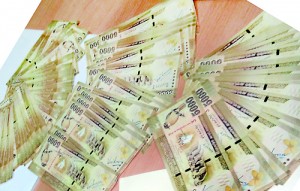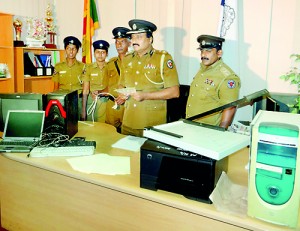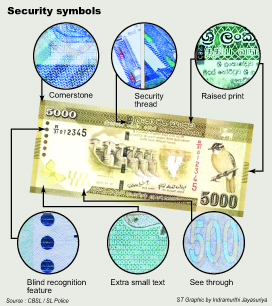News
Young, tech savvy counterfeiters on the increase
Counterfeiter gangs have sharply increased activity in the past 12 months, police said after arresting members of three different gangs last week, some with superior technological skills in making fake money.
One set of arrests took place in Negombo following a tip-off from a man who had rented a house to a person named Vinod. As associate of Vinod had given the man a Rs. 5000 note as part of the rent payment but then quickly changed his mind and

The Rs. 5,000 notes that were seized in Negombo
demanded back the money.
The man returned the money as requested but his suspicions were aroused. Putting together the stories circulating among three-wheeler drivers in the neighbourhood he decided to go to the police.
Negombo police traced the man, who had by then vacated the rented premises, and found him with his baggage in Intercity Estate, Dalupatha. The police also confiscated 288 Rs. 5000 counterfeit notes, two Rs. 1000 notes and one Rs. 5000 note printed only on one side, and a laptop, two desktop computers, a digital colour printer and paper used for printing the fake notes.
A second suspect was arrested later. Both are in their early twenties and believed to be members of a bigger group. The ringleader, Vinod, known for his extravagant lifestyle, is still at large.
Last Sunday, two men in their twenties drove from Kandy to Mawanella, making occasional stops at filling stations and other shops, making various purchases with forged money. Their luck ran out when they became greedy for king coconuts and tried buying some with a forged Rs. 1000 note. The suspicious vendor informed the polic, and the Mawanella police team caught up with the duo soon after.

the police team that conducted the raid. Pix by W. Hubert Fernando
One of the suspects had been working for others for some time, passing around fake notes, and thinking that he deserved a bigger stake in the lucrative business, had decided to strike out on his own. His assistant was a serving soldier on leave. The army has appointed a court of inquiry into the matter.
Acting on a tip-off, Udugama police conducted a raid last week and arrested two individuals, again both in their twenties, in possession of several counterfeit Rs. 1000 and Rs. 500 notes. They confessed to paying their bill at a nearby tea kiosk with a fake Rs. 1000 note. The police also confiscated a printer, scanner and other computer perripherals used to print money. One suspect ran a photo-studio and is well-versed in computer technology, while the other runs a garage.
According to officers involved in these investigations, the suspects had  duplicated most of the security features of the genuine notes but in most cases had failed to duplicate the embossed print. They also failed to replicated the colour-changing feature of the security thread running through the notes. In the original high-value denominations the security thread changes colour from blue to red.
duplicated most of the security features of the genuine notes but in most cases had failed to duplicate the embossed print. They also failed to replicated the colour-changing feature of the security thread running through the notes. In the original high-value denominations the security thread changes colour from blue to red.
Police statistics show that in 2012, 83 people were arrested for possessing forged currency notes while in the first quarter of 2013 alone, 41 were apprehended.
A staggering Rs. 2,498,050 worth of currency was forged in 2012; but again, in the first quarter alone of 2013 Rs. 3,043,570 of forged currency was found.
Police media spokesperson SSP Ajith Rohana said counterfeiting was on the increase.
“In a short period we have conducted a number of major raids in areas such as Malabe, Negombo and Mawanella. The availability of cheap technology such as scanners, printers and computers capable of being used to create forged currency is the main reason for this increase,” he said.
Central Bank Currency Department Superintendent, J.P.R. Karunaratne said notes of higher denominations form the bulk of counterfeit currency with Rs. 1000 notes being the most common.
“We have included a number of features in the notes to ensure that currency cannot be easily forged,” he said. “For instance, we use a special cotton pulp paper which is not freely available. The colour-changing security thread is not easily replicated either.”
Mr. Karunaratne said the public should play an active role in curbing the forgery of currency.
“The public has to pay attention in identifying forged currency. People pay a lot of attention when they buy clothes and other commodities – they should pay attention to the currency notes they exchange as well. It is like any other commodity,” he said.
The Central Bank incorporates security features under three different layers. The first set of security features is to enable the public to identify genuine currency, while the next set is for financial institutions and banks, while the last set of featues for identification purposes by The Central Bank.

